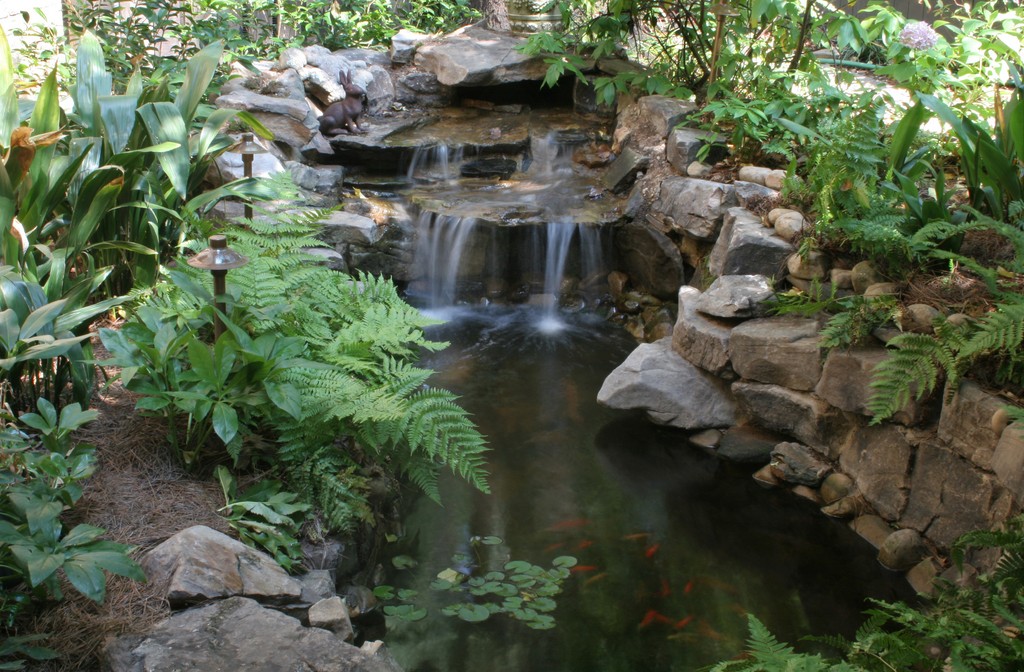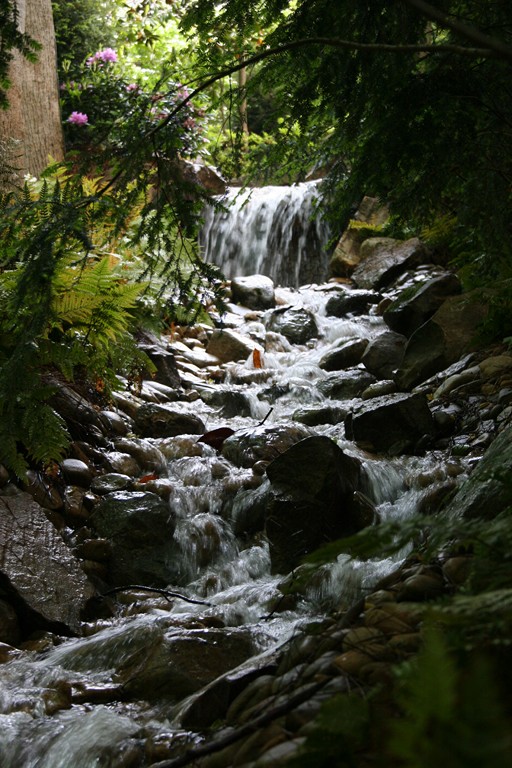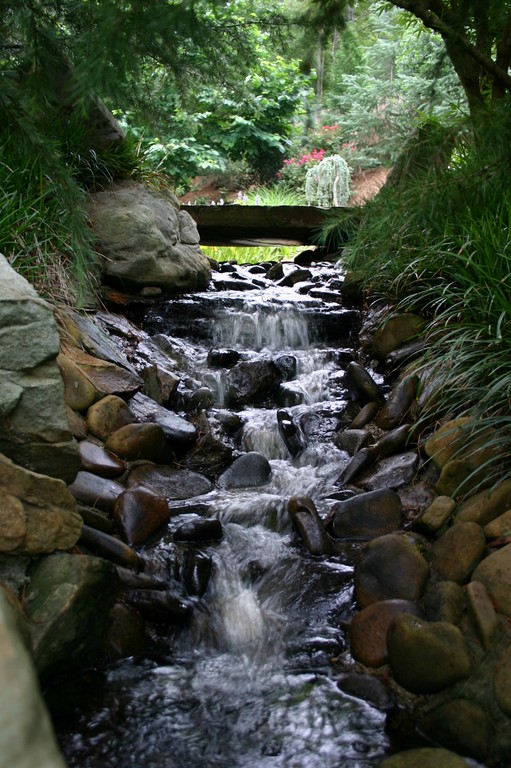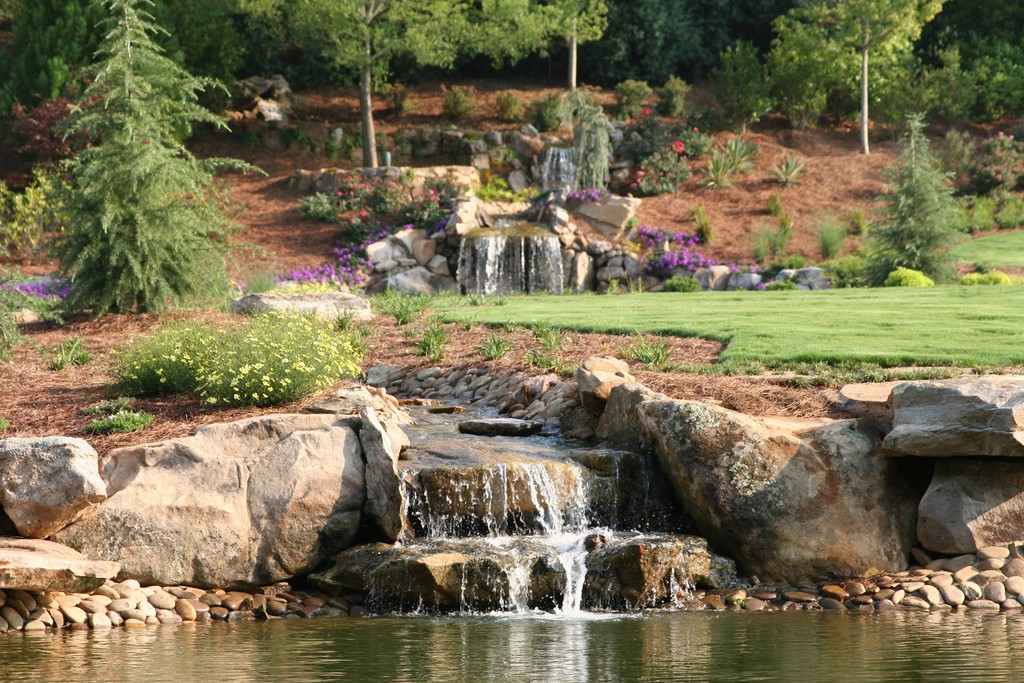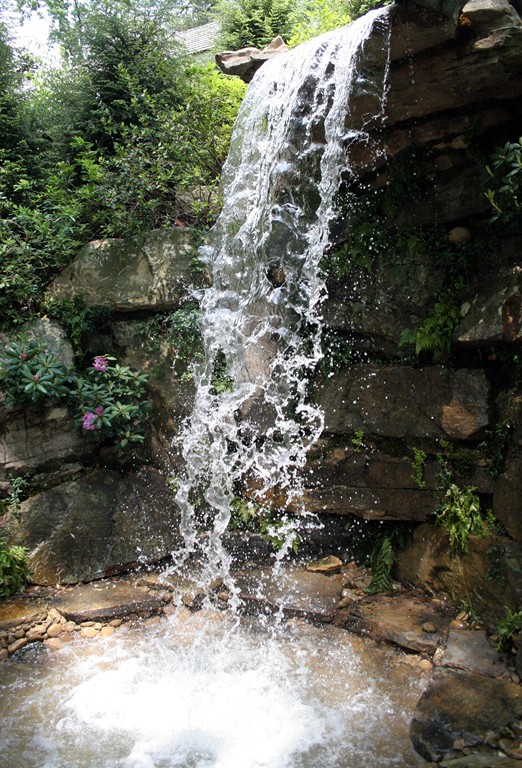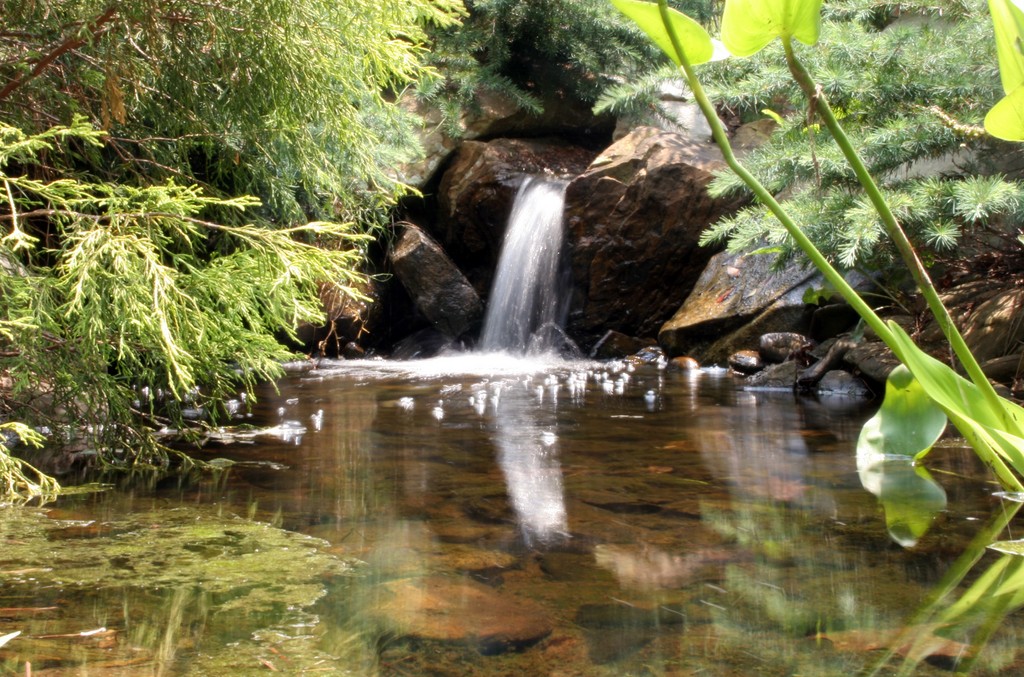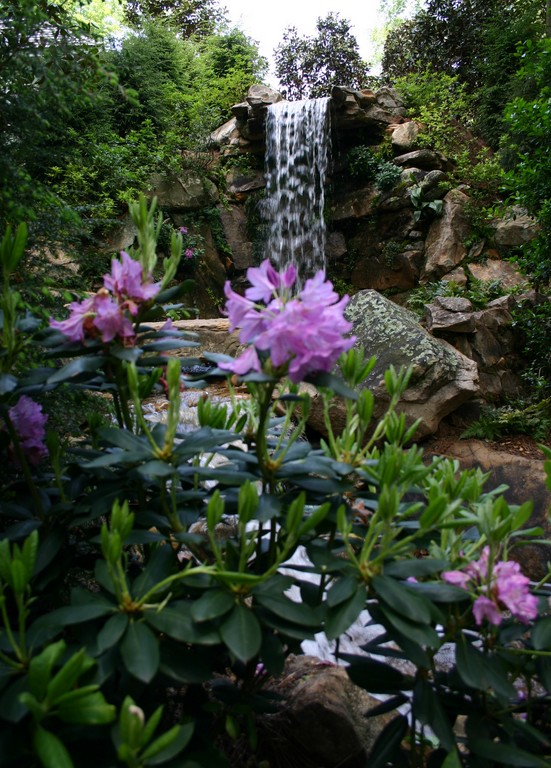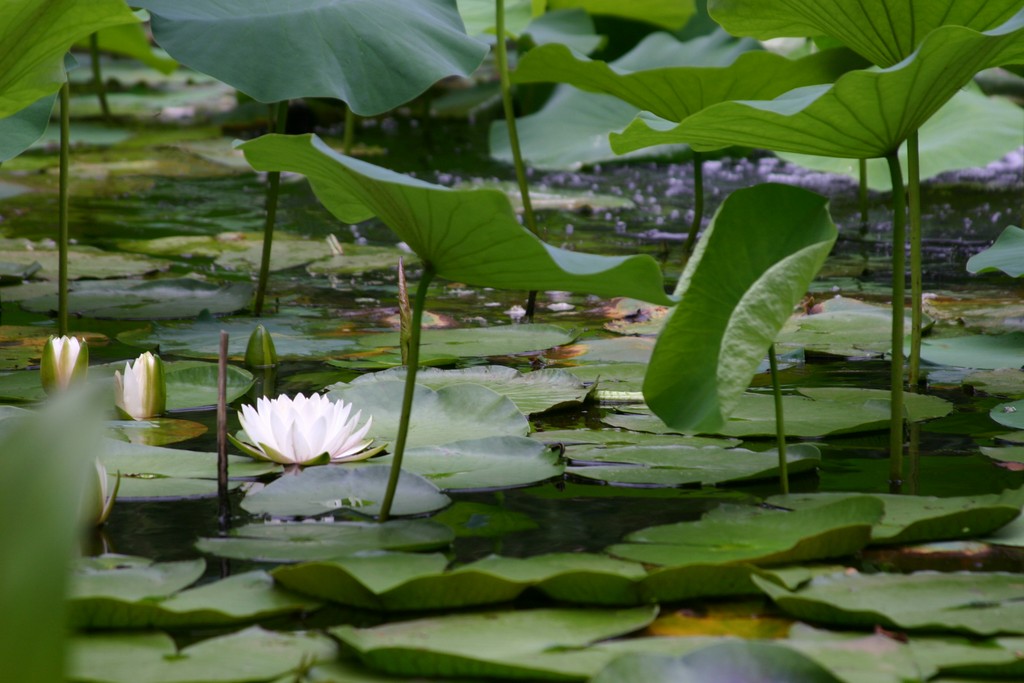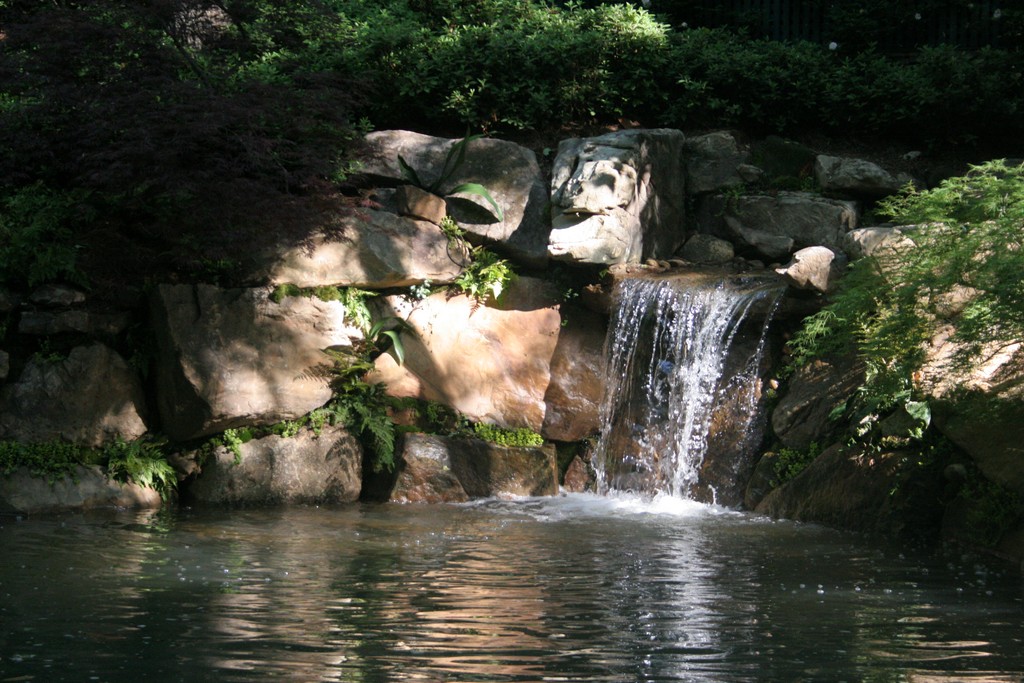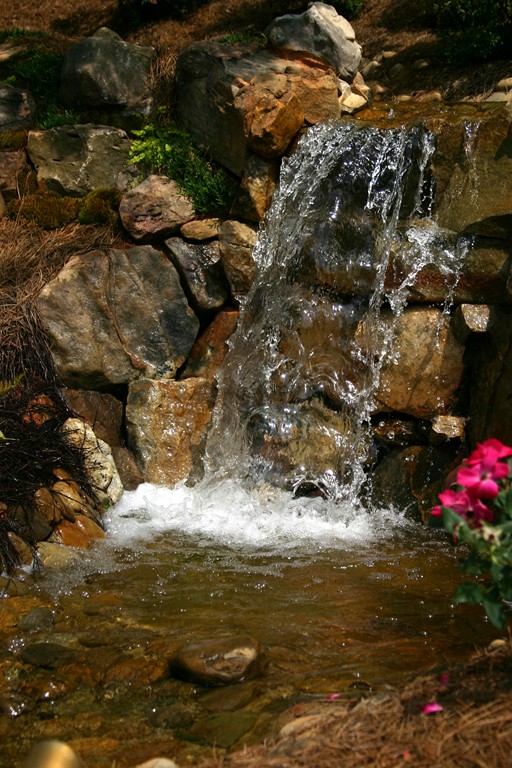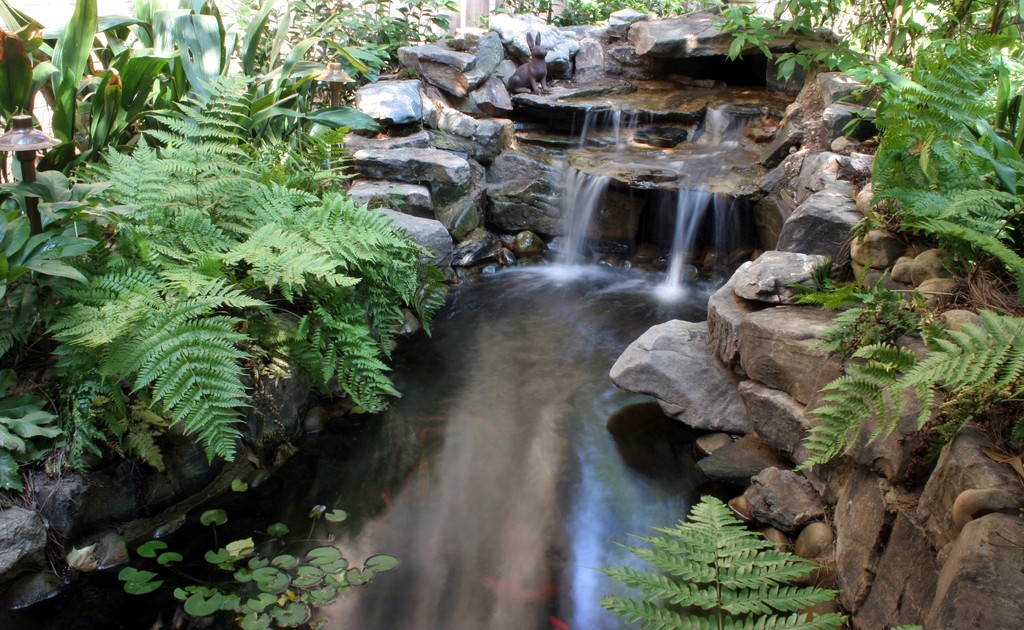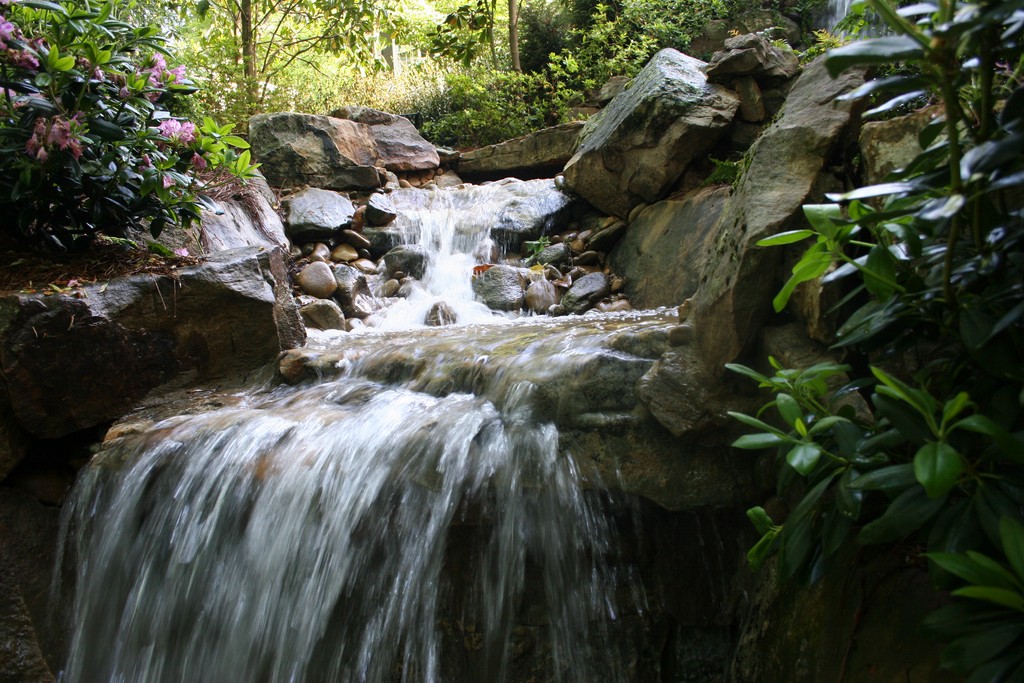Southern Accents

Specializing in naturalistic watershapes obviously requires an appreciation of nature, says Atlanta-based pond/stream specialist Robert Vaughn, but doing a good job of emulating what happens in and around natural bodies of water also calls for a refined set of design and installation skills – especially when the goal is to create watershapes that appear right at home amid rolling topographies and densely wooded landscapes.
The Atlanta area is a great place to be a watershaper these days. The natural landscape is beautiful with its undulating terrain and dense tree canopy, and there are plenty of affluent, upscale neighborhoods in which skills may be applied in support of clients who have the wherewithal to demand something special.
That combination of attributes adds up to great opportunities for companies like mine – Earthwerx of Carterville, Ga. – that focus on crafting nature-inspired paradises in substantial backyards. Indeed, this is a market in which prospective clients are passionate about enjoying their homes and their surroundings instead of engaging in the hassles and perceived risks of travel.
In addition, where property values and home equities in other markets have taken a hit in the past year, the upscale market here has yet to diminish: Our area is still populated by homeowners who desire and can afford to bring a slice of Shangri-La into their lives.
For the past 20 years, I’ve been involved in creating naturalistic ponds, streams and waterfalls for these residences – watershapes that appear as though they’ve always been there. I worked for another firm for the first 17 of those years; then, recognizing an opening at the top of the marketplace, I established my own company three years ago, and I haven’t looked back.
Since making my move, I’ve been involved with a number of amazing clients who want only the very best for their properties. It’s exciting work defined by close collaborations with intelligent homeowners who have a passion for natural beauty and a strong desire to see something gorgeous just beyond the back door.
SMOKEY FOOTHILLS
As we all know, watershaping is a broad-spectrum pursuit in which projects come in a variety of shapes and sizes – some small and subtle, others big and dramatic. We at Earthwerx have done it all, including formal-looking, architecturally driven features, but for the most part, our company is chosen for its ability to create naturalistic systems that give the illusion of having been there long before any homes were built.
There’s no question that the rolling terrain and lush landscapes so common in the Atlanta area are a big factor driving the demand for verdant paradises. Indeed, many of the upscale residential enclaves hereabouts are in the foothills of the Smokey Mountains – a wonderful backdrop and the source of much of our inspiration.
| When it comes to inspiration, the Smokey Mountains are a tremendous resource for watershapers. The landscape is thoroughly eroded, with soft contours, rounded stones and sonorous cascades of a sort we can reproduce for our clients’ properties. |
In geological terms, these mountains are much older than the rugged peaks of the western United States: They’ve been exposed to the elements for a much longer period and have eroded to a smoother state. In addition, our local combination of heat and humidity encourage the growth of lichen and moss on spectacular sandstone outcroppings and have surrounded these features with a huge variety of plants and trees including various oaks, pines, poplars, sweet gums and elms.
As is true of many watershapers and landscape artists, I’ve studied Mother Nature as part of my process of developing my design vocabulary. By looking closely at natural settings, I’ve observed the way stone material is distributed in streams, the way water breaks over rock formations and how erosion affects the landscape.
That said, however, we at Earthwerx don’t deliberately duplicate specific features we find in nature. Instead, we use our observations as points of departure that inform the way our ponds and streams interact with and conform to a given site.
We have a wonderful advantage in that we work mostly with sloping, rolling topographies that readily support our naturalistic endeavors. This allows us to focus almost entirely on giving our watershapes the appearance that they’re nestled in a purely natural environment instead of having been imposed on a site and somewhat separated from it.
In fact, to the greatest extent possible, we’ll always let a site dictate how we’ll incorporate out watershapes within it. Yes, we will reconfigure certain areas to suit our purposes and will add tons of stone material, but mostly we use a site’s natural vertical transitions, stick with indigenous stone varieties and (whenever possible) work without disturbing the existing mature trees we find on almost every property we approach.
CREATIVE JUICES
At this point, almost all of our clients come to us through referrals: They’ve already seen our work, so when we first meet, there’s not much persuasion involved or much need to educate them about our capabilities. In most cases, they also understand and appreciate the notion that our best work will always harmonize with the site.
The fact that they come to the process already understanding so much of what they want and are clear about what we do enables me to jump into the design process right from the start.
| The local topography is just about ideal for the naturalistic watershapes we develop, and we’re fortunate in a great many cases simply to use existing contours in laying them out. Whether steep or more gently sloped, we find this approach helps us generate new watershapes that look as though they’ve always been there. |
After the initial discussion and site visit – and after we’ve come to terms about project scope and a budget – I’ll come back to the site and map out the work with flags and ribbons to give the clients a direct sense of how the water will flow through the property and where the major visual elements will be placed. Typically, this gets them pretty excited and forges a strong sense of conceptual buy-in. We might develop some sketches for planning purposes or to define a specific detail, but for the most part, that’s it: We generally don’t use drawings or other presentation materials to define the design.
It’s not that we don’t value drawing skills, because we do. It’s just that with naturalistic watershapes in particular, I believe you simply cannot get the feel for a design by looking at anything on a flat piece of paper. That’s why we mark the site directly: I want my clients to be able to stand in the space and start visualizing what they’ll eventually see when we’re done – primary viewpoints, vertical transitions, ponds, seating areas and more. To me, this is a far more visceral mode of communication – and a much better way to establish and manage expectations.
(One key point: Because we work so closely with the existing landscape, we usually don’t bring up any planting we might be doing at first, but rather focus mainly on the watershapes as the primary element we’re adding to the property. We’ll talk about pathways, bridges, patios, landings and lighting – all the things that aren’t “there” yet. The plants, which are already part of their surroundings, come later.)
| The heat and humidity that characterize our region make it relatively easy to surround the water with lush plantings and trees of all kinds. The greenery fills in the visual field, offers wonderful shadows and contrasts and, once again, conveys the sense that the water was there long before the property was developed. |
This is, of course, a highly personal (and personalized) process. The work can be intrusive and messy – even with small projects – so, to lessen the blow, we do all we can to help the clients feel involved in the work of art they’re buying. Yes, there are some who just step back and leave everything up to us, but most of the time our clients want to become part of the project team and in many cases become our good friends.
I see getting my clients involved (on whatever level) as being one way to ensure their satisfaction with the outcome. I must say as well that it tends to make the entire process more exciting and enjoyable for everyone.
CAREFUL WEAVING
A big part of why client involvement is so important is because, as most people working in this branch of watershaping will tell you, the actual “design” is created during the installation process rather than beforehand. You establish a basic game plan, of course, but with natural materials such as stone and plants, the details can be created only as they are put in place, component by component.
As suggested above, we have an advantage in our regional topography, so our need to excavate is usually limited. Occasionally, we’ll need to bury large boulders to define major vertical transitions for waterfalls, but compared to what must be done in other areas to achieve these contours, we have an easy time of it.
For all that, we’ve learned through the years that it can take a huge volume of rock material to create a dramatic waterfall, and if there’s one area in which we’ll tend to alter the landscape in significant ways, it’s in these locations.
It is, of course, possible to overdo it with rock. In fact, one of the biggest mistakes I see others make is bringing in too much rock to surround the watercourse. Certainly, stone material is critical to creating major elements within a given naturalistic watershape, but the aim should be to use the stone in harmony with the way it’s naturally distributed throughout the rest of the property and the local area.
|
Canopy Conscious As mentioned in the accompanying text, the presence of mature trees is a significant factor in our Atlanta-area projects. Where we work, widespread development has led to the annual removal of tens of thousands of trees. This has raised the interest among those whose properties have mature trees to protect and preserve them no matter what, all in the name of preserving the defining natural beauty of our region. This is why, to the greatest extent possible, we do all we can to leave the most beautiful specimens on any given property in undisturbed states. Yes, there are times when removing trees and other plant material is unavoidable, but we keep such disruptions to a minimum and always discuss those decisions with our clients before touching a single twig. We also frequently work with arborists: Particularly when we plan to incorporate an existing tree into a design, we want to make sure we’re not harming the tree now in a way that will manifest itself in disease or death later on. In projects where we are contouring slopes by bringing in soil, for example, it’s not unusual that root systems will be buried under new soil. In these situations, we’ll work with the arborist’s recommendations and create “snorkels” that extend down into the root system to provide needed oxygen. We also use their professional guidance in avoiding damage to root systems with our excavations. — R.V. |
In a similar vein, we work hard to bring indigenous plantings to the water’s edge and place them within the boundaries of the stonework. We also work carefully with existing, mature trees, integrating them into our thought processes at an early stage and always keeping their needs in mind. (For more on trees, see the sidebar at right.)
Integrating the watershape into the site also requires us to understand how the work eventually will be seen and from precisely what angles. Whenever possible, I will design a project so you can’t see the entire body of water from one spot: I believe it is always preferable to set things up so scenes unfold and come into view as you move through a space.
I also believe in bringing a portion of the water very near the house itself, for the simple reason that clients enjoy looking out their windows to see the water and only needing to travel a couple paces to reach the water’s edge.
Finally, because the details of these projects are of paramount importance, I believe I must be personally involved in designing and managing every project we do. We never farm out any major portion of watershape or hardscape construction – although we do bring in lighting contractors, electricians, plumbers and carpenters as needed – but I personally oversee the placement of every stone and closely supervise any and all subcontractor activity that can have any long-term aesthetic implications.
WORKING ON SITE
Once on site, the installation and construction techniques we use are fairly straightforward. We use 45-mil liners, covering them entirely with two inches of concrete. Atop that, we’ll spread mortar onto which we place various river rocks, garden boulders and flat rocks. (The liners we use come with 20- to 30-year guarantees, but with the added layer of concrete and additional stone coverage, we conservatively assume these watershapes will perform well for 50 years or longer.)
|
In the Water No matter whether it’s still and reflective, flowing down a stream or falling as a cascade, in all of our projects the characteristics of the water itself are extremely important. Starting at the top of the system, we always conceal the headwaters: There’s nothing that will ruin a natural effect faster than the look of water emerging from a pipe or even passing over a weir. My preference is to create small ponds at the top of our systems, and we usually conceal them at least partly from view with plant material and boulders to lend a sense of mystery to the water’s origins. In the pond itself, the water wells up from the bottom via perforated pipes and then spills into the main flow over small cascades. (For some projects, we’ll add water at strategic locations along the stream, but most of the time, the circulation takes the form of a simple top-to-bottom loop.) What happens between the headwaters and the bottoms of these systems can vary greatly depending on the design. We govern the amount of water in transit with valves that enable us to adjust the flow to meet client desires. In larger projects, we also create various effects by slowing down water in some places to create pools and quiescent areas and by speeding it up in others to create impressions of motion, change and excitement. In doing so, we’re selective when it comes to ways we let water break over falls or cascades. Typically, for example, we avoid configurations where a knife-edge of water flows uniformly over a weir; rather, we’ll fracture these flows (as they most often appear in nature), and I’ll often set up notched or V-shaped weir stones to suggest that water has eroded the edges through the years. At the base of our systems, we never use skimmers because they’re almost impossible to conceal. As an alternative, we set up under-drain systems with perforated pipes that draw water down through layers of river rock and cobble. Not only does this approach give our basins a more natural look, but it also creates a large area of bio-filtration that we see as being far more desirable than using some sort of outboard filtering system. To increase water quality, we occasionally install ultraviolet treatment systems as needed. As a rule, however, we find that if our systems are large enough, the presence of aquatic plants and the aeration provided by falling water are the sufficient to keep water clear and appealing. Finally, one of the big defining factors in the way that we develop the lower watercourses has to do with whether or not fish live in the system. In watershapes that don’t include fish, our ponds are seldom more than 30 inches deep. In those that do, the water will be four feet deep or more – and we’ll also set up places where they can hide from predators and escape direct sunlight. — R.V. |
I’m always amazed when I look at a pond or stream and can see either the liner or exposed patches of concrete – intrusions that instantly deflate “the natural look.” To avoid these visual disruptions, we go to great lengths not only to conceal the concrete, but also to create an extremely natural-looking mix and distribution of stone types and sizes within and beyond the watercourse.
This careful blending of stone types and forms is, again, the product of carefully studying how things appear in nature: There aren’t any formulas to guide you: All you can do is trust your observations and your crew’s experience in helping you place stones in ways that look natural.
As a rule, we don’t use concrete in the larger vertical structures. In these spots, we set the liner in front of the drop and build up structures with carefully stacked rock. This is perhaps the hardest on-site activity we pursue and is certainly the one with both the longest learning curve as well as the longest installation time frame. On the one hand, you have to create stable structures in which gravity firmly locks the boulders in place; on the other, it all has to look natural. As a result, we approach these features as if they were big, three-dimensional jigsaw puzzles, carefully assembling them one piece at a time.
|
Inspiring Sounds That gentle sounds of flowing rivers and babbling brooks are always on my mind when I think about the true pleasures of spending time near natural rivers and streams. As a result, the sounds we build into our own streams and waterfalls is a major design consideration. We know that a single sheet of falling water not only looks unnatural, but it also can sound like the flushing of a massive toilet. This is why we focus on variety: Waterfalls, streams and cascades that have differing treatments of water falling, splashing, dividing and rejoining will provide a far more interesting and harmonious range of sounds – and nothing beats the sounds shallow water makes as it rushes over a rock streambed. — R.V. |
There’s also a huge measure of on-site improvisation that governs these installations. I spend a great deal of time selecting materials, especially the boulders that will form the primary visual elements, but what we see on site once we start wrestling with individual stones is what drives the ultimate appearance. We observe relative sizes and place stones accordingly. We also look for interesting pieces or parts of pieces that have distinct surface characteristics we can use to create focal points, from edges and weirs to flat stepping stones within our larger structures.
Placing these key visual elements is where true artistry comes into play, and we’re always assessing and reassessing our decisions to be sure everything looks both visually attractive and completely natural. That urge to naturalism often leads us to bury large portions of big boulders in the ground, often in ways that end up hiding some of their beautiful characteristics. But that’s the way things are in nature, where large formations always emerge from the soil and you get the impression that what you see on the surface extends deep into the ground below.
SEEKING SATISFACTION
Even though the installation phase of these projects can sometimes be slow going, the process of placing the rocks, reviewing our decisions and, quite often, coming back in and re-doing entire areas always pays off in the end. Through this hard work, we achieve balances among a variety of major aesthetic concerns and create settings in which plant materials, streams, cascades, ponds and stone come together to create an overall impression of nature ceaselessly at work.
| It doesn’t take great observational powers to see that these projects involve a great deal of stone in all shapes and descriptions, from utterly immense boulders to fine gravels and sands. Laying them out is a process or improvisation coupled with a willingness to keep reworking sections of the composition until everything is just right. |
There’s no textbook that can teach you how to create that harmony, and it’s difficult to explain in words – especially give the fact that every project, setting and design are different. As mentioned above, it can be very helpful to use the client as another set of eyes to assist in the process: This is, as was mentioned above, a personal and personalized process, and ultimately clients judge your success or failure. And not only do they enjoy having their say, but they often have good and useful ideas!
This work with naturalistic steams, ponds and waterfalls is hard, physical work, and doing it well means being consumed by it and always making sure that you deliver on your commitment to create spaces that soothe, inspire and revitalize. It also means standing behind the work and being willing and even eager to address client concerns when problems arise.
I take great pride in what we do, and there’s always a wonderful feeling of accomplishment when I step back and partake of the scene once it’s finished. Even more so, it’s gratifying when, years later, I hear from clients who insist on telling me how much they enjoy their watershapes and landscapes – music to my ears!
Robert Vaughn is owner and president of EarthwerX in Cartersville, Ga. A specialist in naturalistic ponds, streams and waterfalls, he founded the firm three years ago to meet the needs of residential clients in the Atlanta metropolitan area. He served in the U.S. Marine Corps from 1971 to 1973, after which he earned a degree in aeronautical engineering from the Detroit Institute of Aeronautics and worked for 15 years as a commercial airline pilot. He subsequently entered the watershaping business and worked for another local firm for about 17 years before starting his own company in 2004.










